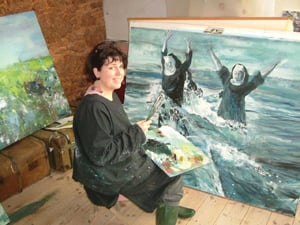What’s up, doc?
Jo Talbot Bowen faced plenty of challenges when she moved from medicine to visual art, but is it really as rocky a road as we imagine?

Wholesale career changes in the arts aren’t unheard of: actors become community workers; directors become teachers; arts professionals move into a myriad of different industries. The leap from culture to education, arts management to the third sector is a path well travelled. But what about switching from a successful career in medicine, in your mid-forties, to one in fine art? I don’t know anyone who’s taken this particular journey but I’m sure there are plenty more like me out there.
MANAGING EXPECTATIONS
I have been practising as an artist in Devon for the past four years, since graduating from University of Plymouth in 2006 with a BA Fine Art. Unsurprisingly perhaps, the expectations of others, even close others, has sometimes been quite difficult; assumptions are made and prejudices leak out. Some of them can be hurtful and irrational: people have asked if I’d encountered a scandal as a doctor, whether I’d been struck off the register, or if I’d hated medicine all along.
It is often assumed that life, financially at least, will be more uncertain and difficult. People worry about making the jump, especially if they have dependents either depending on money, time or care. Others may feel that you are performing a less valuable service to the community and infer that you may be being selfish. Some are embarrassed if they feel art is, or should be, a trivial hobby. There are many strong reactions and not all of them are bad. However, it is the negative ones that prevail and undervalue art while increasing anxiety in a world which difficult and uncertain enough in its own right.
LIFELONG LEARNING
That said, it was as a mature art student learning with plenty of young people (often less than half my age) that I found my own prejudices challenged. Being a medical student meant that I was immersed in externally imposed discipline, extremely hard work and a collective camaraderie. Art school experience was no different, except that there seemed to be far more need for students to have internal discipline. I was constantly amazed at the maturity and resilience of the youngsters who stayed the course. This was humbling and made me feel more determined to give them as much support as I could too. Opportunities for win-win situations abound in creative pathways.
Positive support is required with realistic understanding of what is needed on all sides. Perhaps it is reasonable to share ambition levels and to go through a plan as to how things may work. To this end, I think that a deeper questioning of how you might ‘slot in’ as an artist might be helpful at as early a stage of training as possible. Sometimes mentoring from other more mature graduates or artists’ professional networks you know may also help.
REAPING THE REWARDS
For example, where will you want to work and sell, bearing in mind that many artists are selling online or directly from their studios nowadays? How long may you be in training? Do you envisage further training in teaching (adults or children) or acting as a facilitator in workshops in schools or the community? Do you envisage taking a craft or theory expertise to a further level with an additional course? Would you like to write about art? Do you wish to take the richness of your experience in your first career through to your second in a very manifest way?
In this latter case there is often an assumption that I am now some form of art therapist – another example of how the perception of the caring professions can be hard for other people to give up when you make the move from doctor to artist. Even within my art degree, there were tutors who expected my work to have medical content. There was a sense that this was an obvious USP for me. I think this is an example of labelling where you are defined in terms of your past profession or training. I have seen this happen to accountants and vicars too. It may therefore be important to consider how you project your artist persona and what you put on your artist CV.
Whatever the issues, it is part of the challenge of being an artist that you keep on managing the message you and your work gives out. Social networking, IT, learning and adapting constantly are all key attributes to success in the field, as well, of course, as talent and focus on the work. Becoming an artist is what we artists would all seem to be doing whether we start early or later in life. It is a rewarding change.
Join the Discussion
You must be logged in to post a comment.